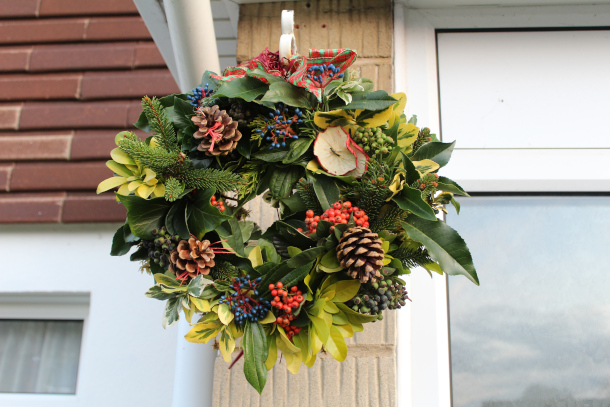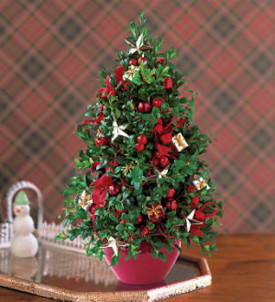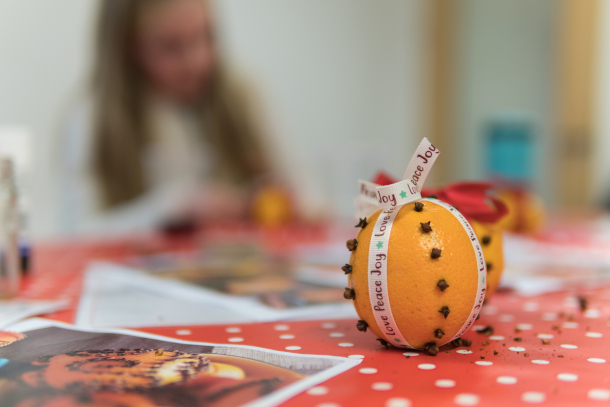Holiday Decor from Your Own Backyard
Air Date: Week of December 16, 2022

Michael Weishan’s tips for creating a winter wreath start with looking for evergreen branches in your own backyard. (Photo: Joybot, Flickr, CC BY-SA 2.0)
With the winter solstice and holidays upon us, many are choosing to bring the outdoors inside with wreaths, garlands, and Christmas trees. Living on Earth's gardening guru, Michael Weishan, joins Host Bobby Bascomb to share some tips on how to craft some festive holiday decor with natural materials from your own backyard.
Transcript
BASCOMB: Well the winter solstice and holiday season are just around the corner now. It’s a time when many of us choose to bring the outside in with a Christmas tree, wreaths, and garland. Those icons of the holiday season can be expensive or if you wait too long, unavailable. But Living on Earth’s gardening guru, Michael Weishan has some alternatives to suggest, and he joins me now. Michael, welcome back to Living on Earth!
WEISHAN: I'm delighted to be back.
BASCOMB: So winter is just about here, the solstice is coming up on the 21st. And households across the country are sprucing up their decor for the new season, for the holidays. What advice do you have for people who maybe want to make decorations with some plants they could find?
WEISHAN: Well, my advice would start with looking your own backyard. One of the things I'm always surprised about is the cost of wreaths and decorations at this time of year, especially here in New England, we had this terrible drought. And so a lot of the Christmas trees and all of the stuff from Canada became very, very costly. So if you have plants growing in your backyard that are evergreen, and I don't just mean pines and balsams, I'm talking about plants like in the South like magnolia, or in the West Coast, bay leaves or rosemary. You can make some terrific Christmas decorations or holiday decorations that will cost you practically nothing. And it's a very simple process.
BASCOMB: So what is the process? How do you go about doing that with things from pine to rosemary, which sounds amazing, by the way. Rosemary, such a beautiful smell.
WEISHAN: Oh, yeah, yeah, I mean, so what you need is a ring, essentially, and you can buy them at any craft store, or you can buy them online. And it's essentially just a series of interlocked wire rings that you build a wreath on. Or you can buy shapes for pendants or in other words, you need some sort of wire support, which you can purchase. And then you essentially just go out and cut a lot of stuff. And it's surprising how much material you actually need for a wreath, which tells you something about why they're so expensive. You can consult many videos on YouTube about exactly how to go about the process. But essentially, you cut material that is going to be of interesting color and contrast. For instance, here I would probably pick yew, dark english yew, and boxwood, and pine, some pine. Southward, I would pick magnolia, along with it's blossoms. And of course box all the way through the south. Anything evergreen. Bay. Laurel is another fantastic leaf texture to use in these wreaths. And you essentially assemble your ingredients in big piles. And then you take some florist's wire and you wire up little brackets of different combinations. Of, say spruce, with some berries or with different leaves and foliage. One of the most beautiful wreaths I saw a number of years ago was actually made from boules of cotton. Granted, I don't have any cotton fields behind me. But for those folks who do, that type of material works really well. And essentially, you use the wire and create these little brackets, tie the stems together, and then you just simply tie the brackets, one on top of the other, around the wreath. It sounds complicated, it's not. You'd be surprised at how simple it really is. And fun. This is a great thing to do with kids, because once you've done the pruning and stuff, you just have piles of greens, right and you can assign them to help make all these little brackets and let them use their imagination and put together colors and combinations and things that you like. And then once you have the base form, you can decorate it with anything. I use all sorts of berries. Our native deciduous hollies, for instance, the ones without the evergreen leaves, have fantastic berries at this time of year. Often crabapples will have wonderful berries. Mahonia, all sorts of shrubs, you know, you name it wherever you are in the world of the United States or beyond, you will have plants that have beautiful berries at this time of year. And you can include them in the wreath and and do this for pennies, literally, compared to $60, $70, $80 for some of these wreaths. Big savings and fun to do.

Evergreen shrubs like boxwood can be trimmed and formed into a tabletop Christmas tree. (Photo: Teleflora Flowers, Flickr, CC BY-NC-ND 2.0)
BASCOMB: Yeah, that's a huge savings. Now what about, you know, people that maybe have waited a little too long to get their Christmas tree and find they're all sold out? I mean, sure, you know, you can go and cut down your own if you live in a place where that's possible. But any alternative suggestions or thoughts for those last minute folks that might be listening to us?
WEISHAN: Well, you know, it's funny, I was just at a large department store chain today and they were selling these little tabletop Christmas trees, the sorts of things you've seen in a Charlie Brown Christmas, you know. And they were $25, $30. And essentially, they're tops of trees, right, you know, they just chop the tree off. I'm thinking, you know, why don't you make these out of boxwood? And I used to do this for many, many years. I may or may not have time to do it this year, but you can just use some equivalent of floral foam, hopefully an ecological version thereof, to mound essentially a large triangle for any size that you want. It can be a foot tall, two feet tall, three feet tall, obviously can't get too big because it'll topple over. Then I just use skewers, bamboo skewers to hold these pieces together and then you put the individual cut pieces of boxwood in them to form a tree of boxwood. And it makes a beautiful tabletop type of Christmas tree that can then be decorated with lights. A friend of mine used to decorate it with long stem roses and other flowers as a centerpiece for the table. It's really lovely and it's very, very easy to do and then just keep it watered over the holiday season and it'll last often way past New Year's.
BASCOMB: Hm. And for people not in New England, you could do the same thing as you were suggesting earlier with rosemary or magnolia or any you know any evergreen that's growing in your region.
WEISHAN: Well remember box is only minimally hardy here in Boston. So all the folks all the way down to almost the panhandle can grow boxwood. And you can also buy, it's very expensive to buy, but you could buy it through florists if you're apartment bound, say in New York City. But again, yes, you could potentially use almost any leaved evergreen. I mean, you could use branches of pine in the far north, you could use anything and create your entire shaped tree. And the nice thing is, your tree, if you do it, right, doesn't have any holes. You know, you can make it as full or as not full as you want. And it's perfect on all sides too, so you can see it from 360. But you're right, absolutely, any type of... I think bay might be kind of fun. I'm a big fan of bay and laurel.
BASCOMB: And you know, I always think it's really fun too to, you know, slice oranges and dry them out to put on a wreath or, you know, make decorations. Any other thoughts along those lines?

Pomanders are a simple craft that leave a warm, aromatic scent throughout the whole room. (Photo: Lee Simpson, Flickr, CC BY-NC-ND 2.0)
WEISHAN: There was this really great project I used to do with my mom at this time of year, which is a strange thing called a pomander. Not something that you hear much anymore, but was essentially just an orange that we then very carefully inserted whole cloves into and then tied it up with a string. It took a long time. I mean, and your fingers got pinched by you know, pushing those bloody cloves into the thing. But by the time you were done, you had this incredible scented pomander that you would hang up in your closet. And it was fantastic because as the orange slowly dried, the scent was revealed. And they would last oh I don't know a good year or so and then it would be time to make them again. Get out the oranges and get out the cloves.
BASCOMB: I love that idea. I'll have to try that with my kids. Michael Weishan is our very own gardening guru and former host of the Victory Garden on PBS. Michael, thank you so much for all of these great ideas today.
WEISHAN: Oh, my pleasure. And happy holidays.
BASCOMB: Oh, same to you. Happy holidays.
Links
Living on Earth wants to hear from you!
Living on Earth
62 Calef Highway, Suite 212
Lee, NH 03861
Telephone: 617-287-4121
E-mail: comments@loe.org
Newsletter [Click here]
Donate to Living on Earth!
Living on Earth is an independent media program and relies entirely on contributions from listeners and institutions supporting public service. Please donate now to preserve an independent environmental voice.
NewsletterLiving on Earth offers a weekly delivery of the show's rundown to your mailbox. Sign up for our newsletter today!
 Sailors For The Sea: Be the change you want to sea.
Sailors For The Sea: Be the change you want to sea.
 Creating positive outcomes for future generations.
Creating positive outcomes for future generations.
 Innovating to make the world a better, more sustainable place to live. Listen to the race to 9 billion
Innovating to make the world a better, more sustainable place to live. Listen to the race to 9 billion
 The Grantham Foundation for the Protection of the Environment: Committed to protecting and improving the health of the global environment.
The Grantham Foundation for the Protection of the Environment: Committed to protecting and improving the health of the global environment.
 Contribute to Living on Earth and receive, as our gift to you, an archival print of one of Mark Seth Lender's extraordinary wildlife photographs. Follow the link to see Mark's current collection of photographs.
Contribute to Living on Earth and receive, as our gift to you, an archival print of one of Mark Seth Lender's extraordinary wildlife photographs. Follow the link to see Mark's current collection of photographs.
 Buy a signed copy of Mark Seth Lender's book Smeagull the Seagull & support Living on Earth
Buy a signed copy of Mark Seth Lender's book Smeagull the Seagull & support Living on Earth

